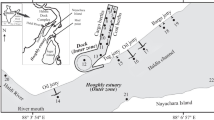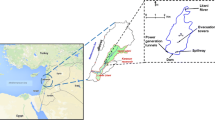Abstract
Temporal variations of phytoplankton primary production in Barra Bonita Reservoir (22° 29′ 5 S, 48° 34′ W, São Paulo State, Brazil) were evaluated by monthly in situ observations in the period July 1993 to June 1994 and by frequent (every 2 days for 4 weeks) sampling during the dry and colder (July) and wet and warmer (January/February) periods. Highest primary production was observed in April (654 mgC m−2 h−1), which also coincided with the period of longest theoretical water retention time. In July, the primary production was the lowest (20 mgC m−2 h−1). Nanoplankton production was the highest in October (192 mgC m−2 h−1) corresponding to 81% of the total. June represented the period with the lowest share of nanoplankton production (17%, 9 mgC m−2 h−1). Nanoplankton was predominant during 8 of the 12 months of observation, representing an average of 41% of the total community primary production. During January/February, most organisms were smaller than 20 μm. Microphytoplankton production was higher in the colder and dryer period. The production values found during the periods of intensive measurements were higher in the wet January/February period, with the average value of 135 mgC m−2 h−1, while the lowest production values were found in the dry winter (July) when they represented 90 mgC m−2 h−1. The cause of the high January values was partially bigger loads of nutrients from the watershed during the high flow, but probably also faster nutrient regeneration at higher temperatures. Barra Bonita primary production is currently three times higher than that observed 15 years ago.
Similar content being viewed by others
References
American Public Health Association, 1985. Standard Methods for the Examination of Water and Wastewater. 16 edn. APHA, AWWA, Washington: 1268 pp.
Bartram, J., W. W. Carmichel, I. Chorus, G. Jones & O. M. Skulberg, 1999. Chapter 1: Introduction. In Chorus, I. & J. Bartram (eds), Toxic Cyanobacteria in Water. E & FN Spon. London: 1–14.
Bray, G. A., 1960. A simple efficient liquid scintillation method for counting aqueous solutions in a liquid scintillation counter. Anal. Biochem. 1: 279–285.
Brylinsky, M., 1980. Estimating the productivity of lakes and reservoirs. In LeCren, E. D. & R. H. Lowe-McConnell (eds), The Functioning of Freshwater Ecosystems. Canbridge University Press. London: 411–453.
Calijuri, M. C., 1985. Curvas de luz – fotossíntese e fatores ecológicos em ecossistema artificial e não estratificado – Represa do Broa ( Lobo) São Carlos. S.P.. Dissertação (Mestrado). PPG em Ecologia e Recursos Naturais, Universidade Federal de São Carlos, São Carlos: 280 pp.
Calijuri, M. C., 1988. Respostas fisioecológicas da comunidade fitoplanctônica e fatores ecológicos em ecossistemas com diferentes estágios de eutrofização. Tese (Doutorado). PPG em Hidráulica e Saneamento, Escola de Engenharia de São Carlos, Universidade de São Paulo, São Carlos: 293 pp.
Calijuri, M. C., 1999. A comunidade Fitoplanctônica em um Reservatório Tropical (Barra Bonita, SP). Tese (Livre-Docência). Escola de Engenharia de São Carlos, Universidade de São Paulo, São Carlos: 211 pp.
Calijuri, M. C. & A. C. A. Dos Santos, 1996. Short-term changes in the Barra Bonita reservoir (São Paulo, Brazil): emphasis on the phytoplankton communities. Hydrobiologia 330: 163–175.
Calijuri, M. C., G. L. B., Deberdt & R. Minoti, 1999. A produtividade primária pelo fitoplâncton na represa de Salto Grande (Americana – SP). In Henry, R. (ed.), Ecologia de Reservatórios: Estrutura, Função e Aspectos Sociais. FAPESP, FUNABIO: 109–148.
Curl, H. Jr. & L. F. Small, 1965. Variations in photosynthetic assimilation ratios in natural, marine phytoplankton communities. Limnol. Oceanogr., Suppl. 10: 67–73.
Dokulil, M., 1979 Optical properties, colour and turbidity. In: Löffler, H. (ed.), Newsiedlersee. The Limnology of a Shallow Lake in the Central Europe. Dr W. Junk Publishers, Boston, London: 203–231.
Dokulil, M., 1984 Assessment of components controlling phytoplankton photosynthesis and bacterioplankton production in a shallow, alkaline, turbid lake (Neusidlersee, Austria). Int. Rev. ges. Hydrobiol. 69: 679–727.
Golterman, H. L., R. S. Clymo & M. A. M. Ohnstad, 1978. Methods for Physical and Chemical Analysis of Freshwaters. 2 edn. IBP, Handbook no 8. Blackwell Scientific Publications, Oxford: 213 pp.
Gunatilaka, A., 1978. Role of seston in the phosphate removal in Neusiedlersee. Verh. int. Ver. Limnol. 20: 986–991.
Harris, G. P., 1994. Phytoplankton Ecology. Chapman and Hall, London.
Harris, G. P., 1999. This is not the end of limnology (or of science): the world may well be a lot simpler than we think. Freshwat. Biol. 42: 689–706.
Harris, G. P. & G. Baxter, 1996. Interannual variability in phytoplankton biomass and species composition in a subtropical reservoir. Freshwat. Biol. 35: 545–560.
Henry, R. & C. A. Simão, 1988. Aspectos sazonais da limitação potencial por N, P, e Fe no fitoplâncton da represa de Barra Bonita (Rio Tietê, SP). Ver. Brasil. Biol. 48(1): 1–14.
Henry, R., K., Hino, J. G. Gentil & J. G. Tundisi, 1985. Primary production and effects of enrichment with nitrate and phosphate on phytoplankton in the Barra Bonita reservoir (State of São Paulo, Brazil). Int. Rev. ges. Hydrobiol. 70(4): 561–573.
Herzig, A., 1976. Der Neusiedlersee – charakteristische Eigenschaften und deren Auswirkungen auf das Zooplankton. Verh. Ges. Ökologie, Wien 1975: 189–196.
Jiao, N. & I. Hsun Ni, 1997. Spatial variations of size-fractionated chlorophyll, cyanobacteria and heterotrophic bacteria in the Central and Western Pacific. Hydrobiologia 352: 219–230. 26
Jørgensen, E. G., 1966. Photosynthetic activity during the life cycle of synchronous Skeletonema cells. Physiol. Pl. 19: 789–799.
Kimmel, B. L. & A. W. Groeger, 1987. Size distribution of planktonic autotrophy and microheterotrophy in DeGray Reservoir Arkansas. In Kennedy, R. H. & J. Nix (eds), Proceedings of the DeGray Lake Symposium. Tech. Report E-87-4. U.S. Army Engineer Waterways Experiment Station, Vicksburg, M.S.: 297–326.
Kimmel, B. L., 1983. Size distribution of planktonic autotrophy and microheterotrophy: implications for organic carbon flow in reservoir foodwebs. Arch. Hydrobiol. 97: 303–319.
Kirk, J. T. O., 1986 Optical Limnological – A manifesto. In De Deckker, P. & W. D. Willians (eds), Limnology in Australia. Australia and Dr W. Junk Publishers, Dordrecht, The Netherlands: 33–62.
Koroleff, F., 1976 Determination of nutrients. In Grasshoff, K. (ed.), Methods of Seawater Analysis. Verlag Chemie Weinhein: 117–181.
Li, W. K.W, B. D. Irwin & P.M. Dickie, 1993. Dark fixation of 14C: variations related to biomass and productivity of phytoplankton and bacteria. Limnol. Oceanogr. 38: 483–494.
Mackereth, F. J. H., J. Heron & J. F. Talling, 1978. Water Analysis: Some Revised Methods for Limnologists. Freshwater Biological Association. Scientific Publication no 36. Titus Wilson & Son Ltd., Kendall: 117 pp.
Neuhuber, F., 1978. Die Phosphorsituation des Neusidlersees. Österr. Wasserwirtschaft 30: 94–99.
Nusch, E. A., 1980. Comparison of different methods for chlorophyll and phaeopigment determination. Arch. Hydrobiol. Beih. Ergebn. Limnol. 14: 14–36.
Oliveira, H. T., 1993. Avaliação das condições limnológicas de um compartimento (Braço do Rio Capivara) e sua interação com o reservatório de Barra Bonita, S.P., com ênfase na comunidade fitoplanctônica. Tese (Doutorado). PPG em Ciências da Engenharia Ambiental, Escola de Engenharia de São Carlos, Universidade de São Paulo, São Carlos. 328 pp.
Reynolds, C. S., 1997. Vegetation processes in the pelagic: a model for ecosystem theory. Excellence In: & Ecology 9, ed. ºKinne, Ecology Institute, Oldendorf/Luhe: 371 pp.
Reynolds, C. S., 1998. The state of freshwater ecology. Freshwat. Biol. 39: 741–753.
Reynolds, C. S., 1999. Phytoplankton assemblages in reservoirs. In Tundisi, J. G. & M. Straskraba (eds), Theoretical Reservoir Ecology and its Applications. IIE. Brazilian Academy of Science. Blackhuys Publ. São Carlos: 439–456.
Sandes, M. A. L., 1998. Estudos ecológicos em florescimento de Microcystis (Cyanobacteria – Cyanophyceae) e interações com a flora bacteriana na Represa de Barra Bonita–Médio Tietê/ SP. Tese (Doutorado). PPG em Ciências da Engenharia Ambiental, Escola de Engenharia de São Carlos, Universidade de São Paulo. São Carlos: 242 pp.
Schindler, D. W., 1978. Factors regulating phytoplankton productions and standing crop in the word's freshwater. Limnol. Oceanogr. 23: 478–496.
Steemann-Nielsen, E., 1952. The use of radioactive carbon (14C) for measuring organic production in the sea. J. Cons. perm. Int. Explor. Mer. 18: 117–140.
Sterner, R. W., J. J. Elser, E. J. Fee, S. J. Guildford & T. H. Chrzanowski, 1997. The light:nutrient ratio in lakes: the balance of energy and materials affects ecosystem structure and process. Am. Nat. 150: 663–684.
Strickland, J. D. & T. R. Parsons, 1960 A manual of sea water analysis. Bull. Fish. Res. Bd Can. 125: 1–185.
Thornthon, K. W., B. L. Kimmel & F. E. Payne, 1990. Reservoir Limnology: ecological perspectives. Wiley-interscience Publ. New York: 246 pp.
Tundisi, J. G., T. Matsumura-Tundisi & M. C. Calijuri, 1993. Limnology and management of reservoirs in Brazil. In Stra¡skraba, M., J. G. Tundisi & A. Duncan (eds), Comparative Reservoir Limnology and Water Quality Management (Developments in Hydrobiology). Kluwer Academic Publishers, Dordrecht: 25–55.
Utermöhl, H., 1958 Zur Vervollkomnung der quantitativen Phytoplankton Methodik. Mitt. int. Ver. Limnol. 9: 1–38.
Wehr, J. D., J. Le & L. Campbell, 1994. Does microbial biomass affect pelagic ecosystem efficiency – an experimental study. Microbiol. Ecol. 27: 1–17.
Westlake, D. F., 1980. Primary production. In LeCren, E. D. & R. H. Lowe-McConnell (eds), The Functioning of Freshwater Ecosystems. Canbridge University Press, London: 411–453.
Wetzel, R. G., 1995. Death, detritus and energy flow in aquatic ecosystems. Freshwat. Biol. 33: 83–89.
Author information
Authors and Affiliations
Rights and permissions
About this article
Cite this article
Calijuri, M., Dos Santos, A. Temporal variations in phytoplankton primary production in a tropical reservoir (Barra Bonita, SP – Brazil). Hydrobiologia 445, 11–26 (2001). https://doi.org/10.1023/A:1017554829992
Issue Date:
DOI: https://doi.org/10.1023/A:1017554829992




